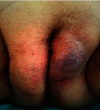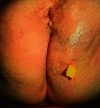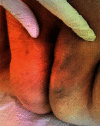Treatment of a Chronic Vulvar Wound by Hyperbaric Oxygen Therapy (HBOT)
- PMID: 35070462
- PMCID: PMC8767409
- DOI: 10.1155/2022/6083915
Treatment of a Chronic Vulvar Wound by Hyperbaric Oxygen Therapy (HBOT)
Abstract
We hereby report the case of a 66-year-old obese patient (BMI 30) with type 2 diabetes, who presented a chronic vulvar lesion on the left labia majora following surgical drainage of an abscess. After multiple unsuccessful treatments by antibiotics and local wound care, we proposed a trial of hyperbaric oxygen therapy (HBOT). The patient fully recovered after 54 sessions at 2.5 ATA, 95 minutes each. HBOT has been studied for perineal lesion such as skin atrophy or necrosis caused by irradiation but not for vulvar nonhealing chronic lesions in the case of impaired vascularization caused by diabetes. This case is, to our knowledge, one of the first publications about the healing boost of HBOT in chronic vulvar wounds due to vascular impairment.
Copyright © 2022 D. Ricard-Gauthier et al.
Conflict of interest statement
The authors declare that they have no conflicts of interest.
Figures




Similar articles
-
Poorly designed research does not help clarify the role of hyperbaric oxygen in the treatment of chronic diabetic foot ulcers.Diving Hyperb Med. 2016 Sep;46(3):133-134. Diving Hyperb Med. 2016. PMID: 27723012
-
Evaluation of hyperbaric oxygen therapy for chronic wounds.J Nippon Med Sch. 2014;81(1):4-11. doi: 10.1272/jnms.81.4. J Nippon Med Sch. 2014. PMID: 24614389
-
Efficacy of hyperbaric oxygen therapy in bacterial biofilm eradication.J Wound Care. 2018 Jan 1;27(Sup1):S20-S28. doi: 10.12968/jowc.2018.27.Sup1.S20. J Wound Care. 2018. PMID: 29334015
-
Proliferative retinopathy during hyperbaric oxygen treatment.Diving Hyperb Med. 2017 Sep;47(3):203. doi: 10.28920/dhm47.3.203. Diving Hyperb Med. 2017. PMID: 28868603 Free PMC article. Review.
-
The use of hyperbaric oxygen therapy to treat chronic wounds: A review.Wound Repair Regen. 2008 May-Jun;16(3):321-30. doi: 10.1111/j.1524-475X.2008.00372.x. Wound Repair Regen. 2008. PMID: 18471250 Review.
References
-
- Stanirowski P. J., Wnuk A., Cendrowski K., Sawicki W. Growth factors, silver dressings and negative pressure wound therapy in the management of hard-to-heal postoperative wounds in obstetrics and gynecology: a review. Archives of Gynecology and Obstetrics . 2015;292(4):757–775. doi: 10.1007/s00404-015-3709-y. - DOI - PMC - PubMed
Publication types
LinkOut - more resources
Full Text Sources
Research Materials

